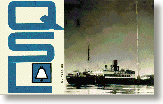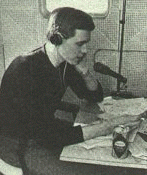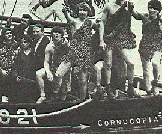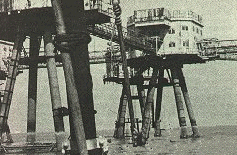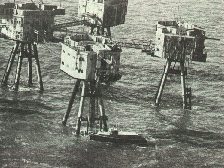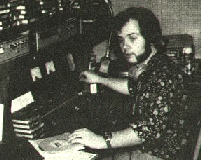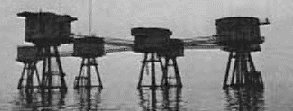|
|
 Sixties City Sixties City |
|
|
Project Atlanta finally managed to secure sufficient finances to purchase her on December 18th and in early January 1964 she once again crossed the Atlantic, arriving in Las Palmas on January 30th, having nearly sunk during the voyage. On February 5th 'Mi Amigo' docked at El Ferrol for repairs and stability modifications to be carried out. |
|
|
While all this was going on, Ronan O'Rahilly, the son of a wealthy Irish industrialist, had also been quietly putting his own plans into action. He had been involved in several enterprises including running an acting school in Knightsbridge in the late Fifties called Studio 57, one of his students there being a certain young man called Simon Dee. By the early Sixties, now as a Soho night-club owner ( 'The Scene' in Great Windmill Street ) and music industry entrepreneur who had been finding it nearly impossible to get airtime for his artists ( including Georgie Fame ) on U.K. mainland stations and Luxembourg, he badly needed a way to break the 'payola' monopoly enjoyed by the 'big four' recording companies Decca, Philips, EMI and Pye. |
|
Inspired by RADIO VERONICA, he had seen the answer to his problems in the creation of his own radio station and at one point had actually discussed the possibilities with Allan Crawford's Project Atlanta. When a series of hold-ups occurred due to the withdrawal of various financial backers he decided to go it alone and eventually acquired the ex-Danish passenger ferry m.v.'Frederica' from the Swiss firm Alranne, renaming it 'Caroline' in honour of John F. Kennedy's daughter. On February 13th it left Rotterdam heading for Greenore in Eire, a port which was owned by his father, to be refitted for broadcasting. The original board of directors for Caroline included John Sheffield ( chairman of Norcros ) and C. E. Ross ( owner of the Ross company group ) who held 88% of the Caroline company's shares between them. Another member of the group of financial backers was Jocelyn Stevens, Sheffield's son-in-law, who was chief editor of 'Queen' magazine and whose Fetter Lane offices the company was to share during the station's launch period. |
|
Two days later on February 15th the 'Mi Amigo' left Spain, also heading for the same port, to have a new aerial mast fitted. This came about as the result of an agreement with Allan Crawford which allowed Ronan O'Rahilly the use of Project Atlanta's London studio to record programmes for RADIO CAROLINE. During February and March both vessels underwent conversions at Greenore but Crawford's ship was required to leave its berth and anchor in the harbour for a week ( to make way for other freighters when her new aerial mast failed to arrive ) which increased her refit time considerably. 'Caroline' left Greenore on March 26th, reached her anchorage five miles off Harwich at 6p.m. on Good Friday March 27th and put out her first test signals the same day at 9p.m. At noon on March 28th 1964 a new era began in British radio history as RADIO CAROLINE broadcast 'Can't Buy Me Love' by The Beatles to the south-east of England on 199 metres 1520kHz. |
|
|
|
The official launch of the station was actually on the following day, Easter Sunday March 29th when disc jockey Simon Dee announced "Hello everybody, this is RADIO CAROLINE broadcasting on 199, your all day music station". Some of the first advertisements carried by the station were for The News of the World, William Hill's Turf Accountants, Ecko Radios, Harp Lager and Kraft Dairylea Cheese. Only three weeks after it started the pirate station had an estimated 7 million listeners! There has always been confusion over the 'firsts' at RADIO CAROLINE so I'll get my two pennyworth in as well - I believe that Chris Moore was the first voice heard, on test transmissions, and his was the first regular record programme on the 29th. Simon Dee ( who had left a comparatively well-paid job with an estate agent to join the station as a disc jockey ) was the first voice heard on the official launch day. |
|
A frustrated, annoyed and disappointed Allan Crawford and 'Mi Amigo' did not leave Greenore until mid-April, the ship's troubles continuing as she sustained damage off Land's End when her radio mast broke on April 21st, forcing her to put into Falmouth for repairs. She eventually reached her anchorage on April 27th, 3.5 miles south-east of Frinton within sight of 'Caroline'. Even then, a further 3-day delay occurred when rough weather made it impossible for the technical staff necessary for operating the transmitters to get aboard. RADIO ATLANTA began 'test' transmissions on May 9th using the wavelength, and therefore audience, of RADIO CAROLINE when she went off the air for the evening. Bob Scott, one of their six disc jockeys, was heard saying between records 'You are tuned to RADIO ATLANTA. This is not a regular format, it is a test format. I repeat, this is a test format' frequently insisting that these were only 'test' transmissions but having the major benefit of advertising the new station to a ready-made audience. |
|
Regular programmes began on May 12th using 200.6 metres 1493kHz - very similar to RADIO CAROLINE - and were broadcast from 6a.m. to 6p.m. which was very soon extended to 8p.m. For the first few weeks the entire broadcasting staff consisted of Texan father and son Johnnie Jackson and Bob Scott who relished in using phrases like 'the most on the coast' 'the music queen of the seven seas' and 'the ship that rocks the ocean'. |
|
|
|
May 1964 was a busy time for the airwaves as RADIO SUTCH, owned by pop singer David ( Screaming Lord ) Sutch, started broadcasting as well. Although originally stating an intention to transmit their programmes from the 60ft fishing trawler 'Cornucopia' from a position four miles off Shoeburyness, the station finally made itself heard broadcasting on 299 metres from the Shivering Sands tower in the Thames Estuary off the coast of Whitstable. |
|
Pop music had started reaching the mainland from a number of unlikely locations and the most ambitious of these was probably a project started in May by shipbuilder Cornelius Verolme which involved the creation of a brand new artificial island off the coast of Holland. The plan was for the company Reklame Exploitatie Maatschoppij to construct the 'island' at his shipyard in Cork and tow it from there to a position about six miles off Noordvijk where it was to be sunk into the sea bed on legs rather like an oil rig. This huge undertaking acquired the name REM Island and was to become the home of RADIO NOORDZEE. |
|
On June 3rd RADIO INVICTA made some test transmissions on a variety of wavelengths from the Red Sands fort in the Thames Estuary 5 miles off Whitstable. It had settled on 390 metres 985kHz by the time it commenced regular broadcasting on July 17th. The station was owned and managed by Tom and Francis Pepper, Charles Evans ( who was later ousted from the group ) and John Thompson, late of the unsuccessful VOICE OF SLOUGH etc. A rag week stunt by some students from Leeds University led to an abortive attempt to start an unnamed pirate station from the yacht 'Carmen' off the coast of Harwich on June 21st. |
|
|
Meanwhile, talks between Allan Crawford and Ronan O'Rahilly ( which had been ongoing since before either station had gone on air and were hastened by pressure on the government from the music industry to outlaw them ) resulted in the merger of RADIO ATLANTA and RADIO CAROLINE on July 2nd 1964, RADIO ATLANTA officially ceasing to exist at 8p.m. on that day. The 'Mi Amigo' started transmitting as RADIO CAROLINE SOUTH from its existing location while the 'Caroline' was moved to an anchorage off Ramsey on the Isle of Man to cover north-west England, Northern and Southern Ireland as RADIO CAROLINE NORTH. During this period the RADIO CAROLINE company moved out of the offices which it shared with 'Queen' magazine into 'Caroline House', a seven-floor building in Chesterfield Gardens, Mayfair where they had their own recording studio built. Spare floor space was rented out to The Moody Blues, Terence Stamp and the Rik Gunnell promotion agency. The company operated under the name of Project Atlanta for a few months before reportedly severing all remaining links with Atlanta and becoming Planet Productions Limited. A minor curiosity occurred on July 5th when a station identifying itself as RADIO FREE YORKSHIRE broadcast fleetingly in the Bridlington area. It was apparently the idea of, and operated by, would-be councillors to show 'the dangers of pirate radio' and possibly holds the distinction of being the shortest-lived transmitting pirate radio station although there were quite a few other serious contenders for this prestigious title. One of these was RADIO RED ROSE which began broadcasting for a few hours on July 12th from the steamship 'Red Rose', anchored about 20 miles off Liverpool. The station was financed by a consortium of Liverpudlian club owners. The exact duration and fate of this station are unknown but some accounts state that it only lasted the one day. The following day RADIO CAROLINE NORTH commenced broadcasting regular programmes between 6a.m. and 9p.m. from its new location off the Isle of Man. Shows included Tom Lodge's 'Rave Party', Jim Murphy's 'Midnite Surf Party' and Don Allen's 'Country & Western Jamboree'. |
|
|
RADIO NOORDZEE began test transmissions in Dutch on July 19th initially using 280 metres 1071kHz, changing to 214 metres 1400kHz before they began regular transmissions between 9a.m. and 6:15p.m. on July 29th. They followed this up with test television transmissions in August leading to a regular television service which started on September 1st, triggering more serious debates in the Dutch parliament. In August, after repeatedly being summonsed and fined for offences against offshore broadcasting laws, Britt Wadner of RADIO SYD was finally sentenced to prison for one month. Amazingly, due to curiosities in the law, she was allowed to continue recording broadcasts for the station from her cell in Hinseberg prison during her incarceration. Her smaller ship 'Cheeta I' ran aground at Malmo on September 17th, holing herself below the waterline. She was towed into Malmo on the 19th and eventually sank in the harbour at Quay 11 on the evening of October 7th. |
|
On the 28th September a survey announced that RADIO CAROLINE had more listeners than BBC RADIO. It was around this time that RADIO VERONICA moved away from pre-recorded material and started broadcasting live from their ship, introducing a new top 40 programme format. Also during September some other short-lived pirate transmissions were heard from RADIO LAMBAY off the Irish coast and RADIO SHANNON which transmitted from the coaster d.s.'Viking'. During September David Sutch's manager Reg Calvert, who wanted the station as a vehicle to promote the pop groups he managed, bought RADIO SUTCH for a reported £5,000 and from September 30th the 3.5kW transmitter was used to broadcast under the new name of RADIO CITY. |
|
The station could be heard from 6a.m. to midnight on 238 metres 1261kHz and apart from the record promotions - they ran a 'new releases' program at 1p.m. each day - its output continued to be fairly footloose and fancy-free. RADIO CITY laid claim to having the first female pirate disc jockey in Peggy Knight and possibly even before her was Reg Calvert's daughter Candy who used to host a show called 'Candy's Pop Shop' during the school holidays! They certainly had the first programme dedicated specifically to the music of The Beatles and The Rolling Stones and also put out a weekly comedy show called 'The Auntie Mabel Hour' in which Ian McRae and Alan Clarke satirised contemporary issues, not unlike the station's original owner. |
|
|
November 19th 1964 saw the arrival of RADIO LONDON, which had set sail from Miami on October 22nd. The ship, converted for broadcasting, had been built in 1944 and was a 780 ton 185ft former U.S. minesweeper 'Manoula' ( also known as 'Density' ), which had been renamed 'Galaxy'. After anchoring in the Thames Estuary she immediately started test transmissions on 412 metres and 324 metres with a 50kW transmitter, which was potentially about ten times more powerful than RADIO CAROLINE. The captain very quickly received a friendly warning from Ronan O'Rahilly that he had mistakenly situated the vessel inside territorial waters, which resulted in a slight positional change to an anchorage three miles off the coast of Frinton and within sight of the 'Mi Amigo'. Following further test transmissions made on December 5th using 265 metres, 277 metres and finally settling on 266 metres, regular programmes began on December 23rd but initially utilised only 17kW of her awesome transmitter power. The first programme was presented by Paul Kaye. |
|
|
RADIO LONDON, also popularly known as BIG L, was backed by a consortium of 17 main shareholders, mostly Texan oil people, under the name of Marine Investments Inc. and was headed by Don Peirson who owned the Abilene National Bank and several automobile agencies. Other top men were Tom Danaher, who also owned automobile agencies and the airport at Wichita Falls, Mal McIlwain of McIlwain Cadillac Company and Ford agencies and Jack McGlothlin who was a Texas oil mogul. |
|
Many of the main
shareholders sub-divided their holdings amongst smaller
investors, allegedly including 'Ladybird' Johnson. This
rumour had its grounds in the fact that the station's
managing director, Philip Birch, had been a guest at the
Johnson's ranch and claimed to have gained presidential
approval for the venture during his stay. |
|
|
Sales manager and disc jockey Ben Toney, who had previously been a director of Fort Worth stations KCUL and KJIM, was brought in as programme director from the American station WTAW to produce a format for the new station in association with ex-RADIO NORD man Gordon McLendon. One of the ideas they introduced led to RADIO LONDON being the first 'British' pirate radio station to carry news bulletins, which were broadcast on the half hour along with a weather forecast. The format was a mix of top 40 records with an occasional 'golden oldie', overseas hit, new release or L.P. track thrown in and was known as the 'Fab 40'. Each 'show' was about 3 hours long, containing about 6 minutes of advertising per hour. The biggest advertiser in the station's early days was Reckitts and their line of products which included 'Beecham's Powders', 'Germolene' and 'Setlers', the latter probably being a popular product on board ship during heavy weather. The RADIO LONDON playlists were organised by the station management and were generally tightly adhered to, at least during the daytime, with presenters not being allowed to make their own selections at all. RADIO CAROLINE's answer to the 'Fab 40' was their 'Sound Sixty Five', but the cramming of so many discs into a three-hour show meant playing only shortish sections from each which effectively meant that the station was really only mimicking what LUXEMBOURG had been doing at the turn of the decade. |
|
The disc jockeys recruited for RADIO
LONDON were mainly fairly highly experienced with the exception of a
19 year old Liverpool lad named Maurice James Christopher Cole, who
was to become better known as Kenny Everett. He and another disc jockey,
Dave Cash, came together in April 1965 to produce a popular, zany show
which, despite only lasting for a few months, achieved a 'cult' status
in the history of pirate radio. They
later recreated this partnership, known as 'Kenny & Cash', for the
land-based commercial station CAPITAL RADIO. |
|
|
Instead of sticking to the playlist it contained a lot of blues music and introduced the British listeners to 'underground' sounds and L.P. tracks from groups like Country Joe and the Fish, Frank Zappa and Velvet Underground which John had been presenting a short time earlier for a Californian station was something of a precursor to the 'hippie' movement of the late Sixties. The station management apparently had a lot less interest in the late night output which allowed John to create a format which he later used to similar good effect in a show called 'Night Ride' on RADIO 1. |
|
|
RADIO LONDON was very professional and soon established itself as the main competitor to RADIO CAROLINE, surprisingly being much more in tune with the 'Ready Steady Go!' Mod scene with its high quality presentation and catchy PAMS jingles. PAMS was a Dallas professional jingle production company set up by Gordon McLendon in the Forties and its products had been used by the KLIF station since 1954. On December 12th 1964
the Dutch government finally made a move and passed a law
which made it illegal to broadcast from structures on the
offshore sea bed. This resulted in the closure of RADIO
NOORDZEE and |
|
|
Tragedy occurred at Red Sands fort on December 16th when RADIO INVICTA co-owner Tom Pepper, engineer Martin Shaw and disc jockey Simon Ashley were drowned in very bad circumstances following the capsizing of their launch after having delivered supplies to the station from Faversham.
|
